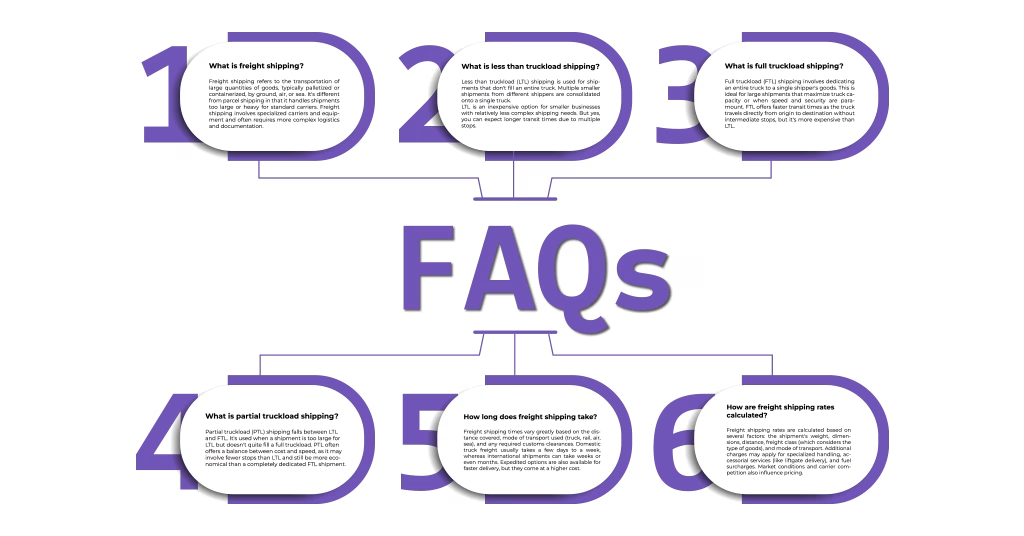FTL and LTL Meaning, Differences, & Use Cases
If you’re in the freight management business, you’re likely familiar with the complexities and occasional frustrations, which are a part and parcel of logistics. Between the myriad carrier options, complex shipping guidelines, and even more complicated rate calculations, it’s easy to feel overwhelmed.
This blog post will make your life a tad bit easier by covering full truckload and less-than-truckload. They are the two most commonly used methods for transporting freight. And the numbers don’t lie!
ال full truckload market is forecast to increase by USD 977.7 billion at a CAGR of 6.08% between 2023 and 2028, whereas the less-than-truckload market is projected to rise by USD 110.7 billion at a CAGR of 6.8% between 2024 and 2029.
But despite these amazing stats, the truck loading sector encounters considerable challenges. Rising inflation puts a pressure on their top line, and capacity constraints make it almost impossible to move goods without any operational hiccups.
Also, a lack of technology adoption impairs their competitiveness, and they find it difficult to keep up with the explosive growth of e-commerce.
Given these market dynamics, a clear understanding of truckload freight shipping is more important than ever. Read on as we define these two shipping methods, explain their key differences, and suggest when each is most appropriate.
How Does Truckload Freight Shipping Work?
Truckload freight shipping is pretty straightforward. It begins with the shipper contacting a carrier or a third-party logistics (3PL) provider. They provide shipment details, including goods, locations, and requirements.
Carriers then generate a bill of lading, which acts as both a receipt and contract. Once confirmed, a truck is dispatched to the pickup location, where the entire shipment is loaded. Upon arrival, the recipient signs a proof of delivery. Finally, the carrier invoices the shipper, and the shipper pays for the service.
Now, let’s break down how freight shipping works vis-à-vis full truckload (FTL) and less than truckload (LTL).
What Is FTL Freight?
FTL shipping is similar to a dedicated courier service for large shipments. It operates on a point-to-point distribution model, meaning your shipment is the sole occupant of the truck from origin to destination. You load your goods onto the truck; it doesn’t make any intermediate stops or handles other shipments midway and travels directly to the final delivery point.
This direct transit is beneficial for several reasons. First, FTL is the standard workhorse for bulk shipments. When you have a large volume of goods, filling a truck to capacity makes economic sense.
Second, FTL is the go-to method for shipments with special handling requirements. If your goods are fragile, temperature-sensitive, or require extra security, having a dedicated truck minimizes the risk of damage or loss. Also, because your shipment remains untouched until it reaches its destination, you have greater control over its journey.
Third, FTL is your best bet when time is of the essence. The direct transit eliminates the delays associated with multiple stops and handling, thereby allowing you to meet tight deadlines and keep your supply chain moving. To reiterate, with FTL, you’re essentially chartering a private carrier for your freight.
What Is LTL Freight?
Conversely, LTL shipping functions on a hub-and-spoke distribution model.
You can picture it as a bus route for freight. LTL shipments are initially collected from various locations within a region. These individual shipments are then transported to a central hub, where they are consolidated and loaded onto a truck. This truck then traverses a multi-stop route, and makes several stopovers to deliver each shipment to its respective destination.
This consolidation process makes LTL a cost-effective option for businesses with smaller, less-than-truckload shipments because instead of paying for an entire truck, you only pay for the portion of space your goods occupy.
For this reason, LTL is particularly well-suited for small and medium-sized businesses that don’t have the volume to justify FTL shipping. However, it’s important to note that LTL shipments usually have longer transit times than FTL shipments.The multiple stops required for pickup and delivery increase the delivery timeline. Also, since your shipment travels alongside other freight, there’s a slightly greater risk of damage or loss compared to the dedicated handling of FTL.
FTL vs LTL: When to Use Each
When choosing between Full Truckload (FTL) and Less Than Truckload (LTL) shipping, carefully evaluate your shipment size, budget, and delivery timeframe.
When to Choose FTL
Select FTL shipping when your shipment occupies a substantial portion of a truck. While you can use FTL for smaller loads, it’s usually more economical to maximize the truck’s capacity. Choose FTL for fragile or valuable goods, as the reduced handling minimizes damage risk. Consider FTL also for time-sensitive deliveries. When you’re on a tight deadline, the direct transit, without intermediate stops, will make sure your shipment is delivered faster.
When to Choose LTL
Select LTL shipping for smaller shipments that don’t need a full truck. Consolidate multiple smaller shipments from various shippers onto one truck to optimize space and reduce costs. Use LTL for budget-conscious shipping when you have smaller volumes. Keep in mind that LTL shipments take longer than FTL. Therefore, LTL is best for non-time-sensitive shipments.
Also, although LTL carriers promise secure handling of goods, the multiple steps of consolidating and de-consolidating freight inherently raise the risk of damage compared to the single-handling, dedicated transport of FTL.
FAQs
- What is freight shipping?
Freight shipping refers to the transportation of large quantities of goods, typically palletized or containerized, by ground, air, or sea. It’s different from parcel shipping in that it handles shipments too large or heavy for standard carriers. Freight shipping involves specialized carriers and equipment and often requires more complex logistics and documentation.
- What is less than truckload shipping?
Less than truckload (LTL) shipping is used for shipments that don’t fill an entire truck. Multiple smaller shipments from different shippers are consolidated onto a single truck.
LTL is an inexpensive option for smaller businesses with relatively less complex shipping needs. But yes, you can expect longer transit times due to multiple stops.
- What is full truckload shipping?
Full truckload (FTL) shipping involves dedicating an entire truck to a single shipper’s goods. This is ideal for large shipments that maximize truck capacity or when speed and security are paramount. FTL offers faster transit times as the truck travels directly from origin to destination without intermediate stops, but it’s more expensive than LTL.
- What is partial truckload shipping?
Partial truckload (PTL) shipping falls between LTL and FTL. It’s used when a shipment is too large for LTL but doesn’t quite fill a full truckload. PTL often offers a balance between cost and speed, as it may involve fewer stops than LTL and still be more economical than a completely dedicated FTL shipment.
- How long does freight shipping take?
Freight shipping times vary greatly based on the distance covered, mode of transport used (truck, rail, air, sea), and any required customs clearances. Domestic truck freight usually takes a few days to a week, whereas international shipments can take weeks or even months. Expedited options are also available for faster delivery, but they come at a higher cost.
- How are freight shipping rates calculated?
Freight shipping rates are calculated based on several factors: the shipment’s weight, dimensions, distance, freight class (which considers the type of goods), and mode of transport. Additional charges may apply for specialized handling, accessorial services (like liftgate delivery), and fuel surcharges. Market conditions and carrier competition also influence pricing.
Optimize the Load Balance for Your Fleet
Ensuring your fleet operates at peak efficiency means optimizing load distribution while keeping real-time visibility of each vehicle. Mile’s logistics management software helps you utilize available capacity to the fullest and cover more touchpoints with every trip.
Make Full Use of Weight and Space
Factor in both volume and weight to maximize each truck’s capacity and avoid wasted space. Organize shipments properly to transport more goods using the same resources.
Assign Shipments to the Right Truck and Driver
Use GPS tracking and smart, AI-powered shipment assignment features to match each driver with the best-fit vehicle and route for smoother deliveries.
Avoid Wasted Trips and Downtime
Plan smarter schedules to match destination hubs’ time slots, so trucks aren’t sitting idle or driving empty miles. Prevent overloaded routes, reduce unnecessary hold-ups, and support safe driving conditions.
Choose Routes That Save Time and Distance
Select the quickest paths and reroute instantly as and when needed. Update ETAs on the go with real-time fleet tracking. Deliver the shipment as per schedule.
Track Your Entire Fleet on One Dashboard
Get a complete view of your fleet’s movement with live tracking. Follow each truck’s location, track pickup and delivery schedules, monitor SLA compliance, and stay informed about on-ground events as they happen.


